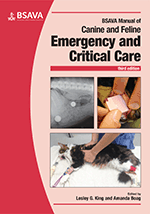
Full text loading...

This chapter considers the causes, clinical signs, diagnosis and management of the following endocrine emergencies: diabetic ketoacidosis, insulinoma, hypoadrenocorticism, hyperaldosteronism, hyperadrenocorticism, hyperparathyroidism, hypoparathyroidism and phaeochromocytoma.
Endocrine emergencies, Page 1 of 1
< Previous page | Next page > /docserver/preview/fulltext/10.22233/9781910443262/9781910443262.16-1.gif

Full text loading...







